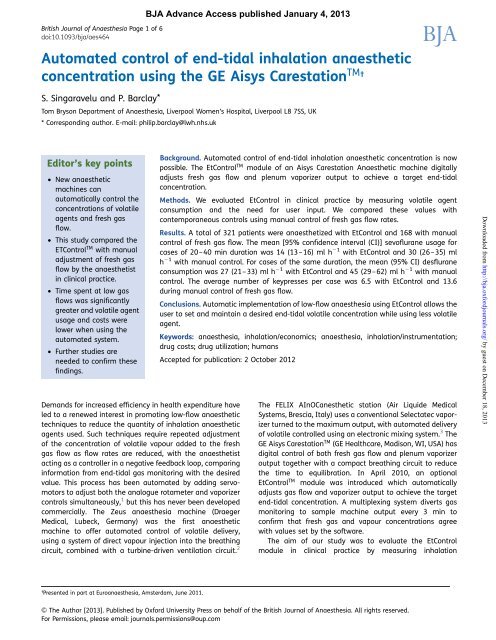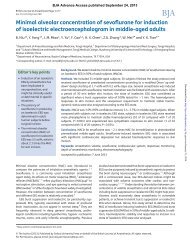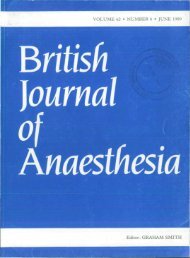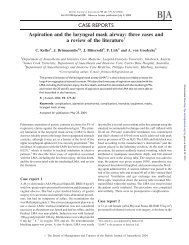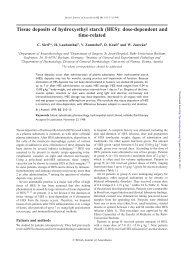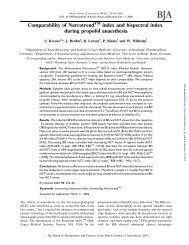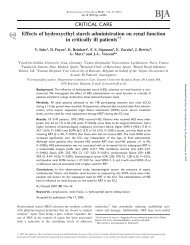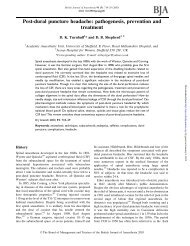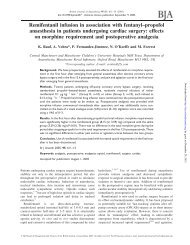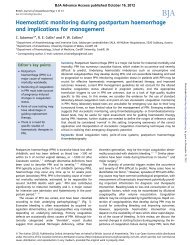Automated control of end-tidal inhalation anaesthetic ... - BJA
Automated control of end-tidal inhalation anaesthetic ... - BJA
Automated control of end-tidal inhalation anaesthetic ... - BJA
You also want an ePaper? Increase the reach of your titles
YUMPU automatically turns print PDFs into web optimized ePapers that Google loves.
British Journal <strong>of</strong> Anaesthesia Page 1 <strong>of</strong> 6<br />
doi:10.1093/bja/aes464<br />
<strong>Automated</strong> <strong>control</strong> <strong>of</strong> <strong>end</strong>-<strong>tidal</strong> <strong>inhalation</strong> <strong>anaesthetic</strong><br />
concentration using the GE Aisys Carestation TM†<br />
S. Singaravelu and P. Barclay*<br />
<strong>BJA</strong> Advance Access published January 4, 2013<br />
Tom Bryson Department <strong>of</strong> Anaesthesia, Liverpool Women’s Hospital, Liverpool L8 7SS, UK<br />
* Corresponding author. E-mail: philip.barclay@lwh.nhs.uk<br />
Editor’s key points<br />
† New <strong>anaesthetic</strong><br />
machines can<br />
automatically <strong>control</strong> the<br />
concentrations <strong>of</strong> volatile<br />
agents and fresh gas<br />
flow.<br />
† This study compared the<br />
ETControl TM with manual<br />
adjustment <strong>of</strong> fresh gas<br />
flow by the anaesthetist<br />
in clinical practice.<br />
† Time spent at low gas<br />
flows was significantly<br />
greater and volatile agent<br />
usage and costs were<br />
lower when using the<br />
automated system.<br />
† Further studies are<br />
needed to confirm these<br />
findings.<br />
Demands for increased efficiency in health exp<strong>end</strong>iture have<br />
led to a renewed interest in promoting low-flow <strong>anaesthetic</strong><br />
techniques to reduce the quantity <strong>of</strong> <strong>inhalation</strong> <strong>anaesthetic</strong><br />
agents used. Such techniques require repeated adjustment<br />
<strong>of</strong> the concentration <strong>of</strong> volatile vapour added to the fresh<br />
gas flow as flow rates are reduced, with the anaesthetist<br />
acting as a <strong>control</strong>ler in a negative feedback loop, comparing<br />
information from <strong>end</strong>-<strong>tidal</strong> gas monitoring with the desired<br />
value. This process has been automated by adding servomotors<br />
to adjust both the analogue rotameter and vaporizer<br />
<strong>control</strong>s simultaneously, 1 but this has never been developed<br />
commercially. The Zeus anaesthesia machine (Draeger<br />
Medical, Lubeck, Germany) was the first <strong>anaesthetic</strong><br />
machine to <strong>of</strong>fer automated <strong>control</strong> <strong>of</strong> volatile delivery,<br />
using a system <strong>of</strong> direct vapour injection into the breathing<br />
circuit, combined with a turbine-driven ventilation circuit. 2<br />
Background. <strong>Automated</strong> <strong>control</strong> <strong>of</strong> <strong>end</strong>-<strong>tidal</strong> <strong>inhalation</strong> <strong>anaesthetic</strong> concentration is now<br />
possible. The EtControl TM module <strong>of</strong> an Aisys Carestation Anaesthetic machine digitally<br />
adjusts fresh gas flow and plenum vaporizer output to achieve a target <strong>end</strong>-<strong>tidal</strong><br />
concentration.<br />
Methods. We evaluated EtControl in clinical practice by measuring volatile agent<br />
consumption and the need for user input. We compared these values with<br />
contemporaneous <strong>control</strong>s using manual <strong>control</strong> <strong>of</strong> fresh gas flow rates.<br />
Results. A total <strong>of</strong> 321 patients were anaesthetized with EtControl and 168 with manual<br />
<strong>control</strong> <strong>of</strong> fresh gas flow. The mean [95% confidence interval (CI)] sev<strong>of</strong>lurane usage for<br />
cases <strong>of</strong> 20–40 min duration was 14 (13–16) ml h 21 with EtControl and 30 (26–35) ml<br />
h 21 with manual <strong>control</strong>. For cases <strong>of</strong> the same duration, the mean (95% CI) desflurane<br />
consumption was 27 (21–33) ml h 21 with EtControl and 45 (29–62) ml h 21 with manual<br />
<strong>control</strong>. The average number <strong>of</strong> keypresses per case was 6.5 with EtControl and 13.6<br />
during manual <strong>control</strong> <strong>of</strong> fresh gas flow.<br />
Conclusions. Automatic implementation <strong>of</strong> low-flow anaesthesia using EtControl allows the<br />
user to set and maintain a desired <strong>end</strong>-<strong>tidal</strong> volatile concentration while using less volatile<br />
agent.<br />
Keywords: anaesthesia, <strong>inhalation</strong>/economics; anaesthesia, <strong>inhalation</strong>/instrumentation;<br />
drug costs; drug utilization; humans<br />
Accepted for publication: 2 October 2012<br />
The FELIX AInOCanesthetic station (Air Liquide Medical<br />
Systems, Brescia, Italy) uses a conventional Selectatec vaporizer<br />
turned to the maximum output, with automated delivery<br />
<strong>of</strong> volatile <strong>control</strong>led using an electronic mixing system. 3 The<br />
GE Aisys Carestation TM (GE Healthcare, Madison, WI, USA) has<br />
digital <strong>control</strong> <strong>of</strong> both fresh gas flow and plenum vaporizer<br />
output together with a compact breathing circuit to reduce<br />
the time to equilibration. In April 2010, an optional<br />
EtControl TM module was introduced which automatically<br />
adjusts gas flow and vaporizer output to achieve the target<br />
<strong>end</strong>-<strong>tidal</strong> concentration. A multiplexing system diverts gas<br />
monitoring to sample machine output every 3 min to<br />
confirm that fresh gas and vapour concentrations agree<br />
with values set by the s<strong>of</strong>tware.<br />
The aim <strong>of</strong> our study was to evaluate the EtControl<br />
module in clinical practice by measuring <strong>inhalation</strong><br />
Downloaded from http://bja.oxfordjournals.org/ by guest on December 18, 2013<br />
†<br />
Presented in part at Euroanaesthesia, Amsterdam, June 2011.<br />
& The Author [2013]. Published by Oxford University Press on behalf <strong>of</strong> the British Journal <strong>of</strong> Anaesthesia. All rights reserved.<br />
For Permissions, please email: journals.permissions@oup.com
Cumulative frequency (%)<br />
<strong>BJA</strong><br />
Singaravelu and Barclay<br />
<strong>anaesthetic</strong> usage and the need for user intervention and<br />
comparing this with contemporaneous cases undertaken<br />
using manual <strong>control</strong> <strong>of</strong> fresh gas flow.<br />
Methods<br />
End-<strong>tidal</strong> <strong>control</strong> (EtControl) hardware and s<strong>of</strong>tware was<br />
fitted to five GE Aisys machines in the Gynaecology Theatres<br />
<strong>of</strong> the Liverpool Women’s Hospital in April 2010. In the fresh<br />
gas <strong>control</strong> mode, anaesthetists use three <strong>control</strong>s to manually<br />
set the oxygen mixture, fresh gas flow, and percentage<br />
volatile output as required throughout the case. Where the<br />
EtControl mode is used, anaesthetists set targets for <strong>end</strong><strong>tidal</strong><br />
oxygen concentration, minimum flow rate, and <strong>end</strong><strong>tidal</strong><br />
volatile concentration. The system uses an algorithm<br />
to adjust both fresh gas flow and vaporizer to achieve the<br />
set values via a negative feedback <strong>control</strong> system, although<br />
the precise details <strong>of</strong> the algorithm are uncertain. Fresh<br />
gas flow automatically reduces down to the minimum set<br />
value, although this can be increased during the case to<br />
compensate for system leaks.<br />
We performed a service evaluation between June 2010<br />
and October 2010 to observe fresh gas flow rates and <strong>inhalation</strong><br />
<strong>anaesthetic</strong> usage in clinical practice where the anaesthetist<br />
had used either EtControl or fresh gas <strong>control</strong>. The<br />
project was approved by the Trust audit committee.<br />
No patient identification information was collected during<br />
the audit. All information was collected from the log files<br />
stored within the Aisys <strong>anaesthetic</strong> machine. EtControl data<br />
were analysed from the files generated for each case that<br />
store breath-by-breath information about 114 variables<br />
derived from raw and processed data obtained from the<br />
Aisys machine, with an average time interval <strong>of</strong> 5.0 s. Data<br />
log files were obtained from each <strong>of</strong> the machines by our<br />
senior Biomedical Engineer using a Compact Flash card. Information<br />
from each log file was imported into a Micros<strong>of</strong>t<br />
Excel 2010 spreadsheet template [Micros<strong>of</strong>t (2010),<br />
Redmond, WA, USA], which contained formulae described<br />
in the App<strong>end</strong>ix, to calculate each <strong>of</strong> the variables described<br />
in the Results. The accuracy <strong>of</strong> <strong>control</strong> and bias were measured<br />
during conditions <strong>of</strong> steady state, defined as .300 s<br />
after a change in target concentration.<br />
Fewer data were available for patients who received anaesthesia<br />
using fresh gas <strong>control</strong> as the Aisys s<strong>of</strong>tware<br />
does not currently output data about flow rates or vaporizer<br />
settings. Instead, the keypress logfile was analysed, to determine<br />
user settings <strong>of</strong> fresh gas flow and vaporizer output<br />
during each case.<br />
All patients received sev<strong>of</strong>lurane or desflurane. Patients<br />
with a duration <strong>of</strong> anaesthesia <strong>of</strong> ,10 min were excluded,<br />
as there were insufficient data to perform a full analysis <strong>of</strong><br />
the system performance in the maintenance phase <strong>of</strong><br />
anaesthesia.<br />
For comparison, Dr Ross Kennedy (Department <strong>of</strong> Anaesthesia,<br />
Parkside, Christchurch Hospital, University <strong>of</strong> Otago,<br />
Christchurch, New Zealand) kindly supplied us with original<br />
Page 2 <strong>of</strong> 6<br />
data from his 2006 and 2009 studies <strong>of</strong> the changing patterns<br />
<strong>of</strong> fresh gas flow rates. 4<br />
Data were analysed with Graphpad Prism version 5.01 for<br />
Windows (GraphPad S<strong>of</strong>tware, San Diego, CA, USA, www.<br />
graphpad.com) using the Spearman correlation and t-tests.<br />
Results<br />
During the evaluation period, we observed routine <strong>anaesthetic</strong><br />
practice, leaving the choice <strong>of</strong> <strong>inhalation</strong> <strong>anaesthetic</strong>,<br />
fresh gas flow rate, and method <strong>of</strong> flow rate adjustment to<br />
the discretion <strong>of</strong> the individual anaesthetist. A total <strong>of</strong> 321<br />
patients were anaesthetized using EtControl <strong>of</strong> fresh gas<br />
flow, 181 receiving sev<strong>of</strong>lurane and 140 receiving desflurane.<br />
Data were also obtained from 168 patients who had manual<br />
<strong>control</strong> <strong>of</strong> fresh gas flow during the same time period; <strong>of</strong><br />
whom, 143 received sev<strong>of</strong>lurane and 25 received desflurane.<br />
The time spent at each gas flow rate during the first 10<br />
min <strong>of</strong> anaesthesia is shown in Figure 1. The gas flow<br />
pr<strong>of</strong>ile for the total duration <strong>of</strong> anaesthesia is shown in<br />
Figure 2, together with data from Kennedy and French. 4<br />
The average fresh gas flow during EtControl decreased significantly<br />
with increased duration <strong>of</strong> anaesthesia (Spearman<br />
r¼20.88, P¼0.0016). The average fresh gas flow and rate <strong>of</strong><br />
liquid volatile agent usage, categorized by duration <strong>of</strong> anaesthesia,<br />
is shown in Table 1. The cost <strong>of</strong> anaesthesia in £ h 21 is<br />
shown in Figure 3, using prices from the BNF. 5<br />
100<br />
90<br />
80<br />
70<br />
60<br />
50<br />
40<br />
30<br />
20<br />
10<br />
0<br />
0 – 0.5<br />
0.5 – 1<br />
1 – 1.5<br />
1.5 – 2<br />
2.0 – 2.5<br />
2.5 – 3.0<br />
3.0 – 4.0<br />
EtC<br />
Manual<br />
Fresh gas flow rate (litre min –1 )<br />
4.0 – 6.0<br />
≥ 6.0<br />
Fig 1 Cumulative frequency graph showing the amount <strong>of</strong> time<br />
spent in each fresh gas flow range during the first 10 min <strong>of</strong> <strong>end</strong><strong>tidal</strong><br />
<strong>control</strong> and manual <strong>control</strong> <strong>of</strong> anaesthesia.<br />
Downloaded from http://bja.oxfordjournals.org/ by guest on December 18, 2013
<strong>Automated</strong> <strong>control</strong> <strong>of</strong> <strong>end</strong>-<strong>tidal</strong> <strong>inhalation</strong> concentrations<br />
<strong>BJA</strong><br />
100<br />
90<br />
80<br />
A<br />
30<br />
Cumulative frequency (%)<br />
70<br />
60<br />
50<br />
40<br />
30<br />
20<br />
10<br />
0<br />
0 – 0.5<br />
0.5 – 1<br />
1 – 1.5<br />
1.5 – 2<br />
2.0 – 2.5<br />
2.5 – 3.0<br />
3.0 – 4.0<br />
Fresh gas flow rate (litre min –1 )<br />
EtC<br />
Kennedy 2006<br />
Kennedy 2009<br />
Manual<br />
4.0 – 6.0<br />
≥ 6.0<br />
Fig 2 Cumulative frequency graph showing the quantity <strong>of</strong> time<br />
spent at each flow rate during <strong>end</strong>-<strong>tidal</strong> <strong>control</strong> and manual<br />
<strong>control</strong> <strong>of</strong> anaesthesia, together with data provided by Kennedy<br />
from his 2006 and 2009 studies. 4 – 6<br />
Table 1 Fresh gas flow and liquid volatile <strong>anaesthetic</strong> usage,<br />
categorized by duration <strong>of</strong> <strong>anaesthetic</strong>. Data are presented as<br />
mean (95% CI), with duration <strong>of</strong> anaesthesia categories in<br />
minutes<br />
Duration Et Control Manual <strong>control</strong><br />
Mean (95% CI) n Mean (95% CI) n<br />
Fresh gas flow (litre min 21 )<br />
,20 1.4 (1.1–1.7) 41 3.6 (3.3–3.9) 86<br />
20–40 1.2 (1.1–1.4) 76 3.1 (2.7–3.5) 42<br />
40–60 0.9 (0.8–1) 87 1.9 (1.7–2.1) 20<br />
.60 0.7 (0.7–0.8) 117 1.5 (1.3–1.7) 20<br />
Liquid sev<strong>of</strong>lurane usage (ml h 21 )<br />
,20 15 (12–17) 31 33 (30–37) 79<br />
20–40 14 (13–16) 55 30 (26–35) 34<br />
40–60 11 (10–12) 52 20 (14–27) 14<br />
.60 9 (8–9) 43 14 (12–17) 16<br />
Liquid desflurane usage (ml h 21 )<br />
,20 32 (25–39) 10 75 (50–100) 7<br />
20–40 27 (21–33) 21 45 (29–62) 8<br />
40–60 19 (17–20) 35 33 (30–35) 6<br />
.60 17 (15–18) 74 33 (23–43) 4<br />
With EtControl, the measured <strong>end</strong>-<strong>tidal</strong> concentration was<br />
within 10% <strong>of</strong> the set target for 98.0% <strong>of</strong> the total time spent<br />
in steady state, allowing 5 min for equilibration after each<br />
change in the set target. The mean [95% confidence interval<br />
(CI)] bias was +1.47 (1.29–1.66)% <strong>of</strong> the target. The mean<br />
Cost (£ h –1 )<br />
B<br />
Cost (£ h –1 )<br />
20<br />
10<br />
(95% CI) number <strong>of</strong> keypresses required was 6.5 (6.0–7.0)<br />
during EtControl and 13.6 (12.8–14.4) during manual <strong>control</strong>.<br />
Discussion<br />
Manual sev<strong>of</strong>lurane<br />
EtC sev<strong>of</strong>lurane<br />
0<br />
0 20 40 60 80 100 120 140 160 180 200<br />
Time (min)<br />
30<br />
20<br />
10<br />
0<br />
0 20 40 60 80 100 120 140 160 180 200<br />
Time (min)<br />
Manual desflurane<br />
EtC desflurane<br />
Fig 3 Mean cost <strong>of</strong> volatile liquid per hour <strong>of</strong> anaesthesia (£ h 21 )<br />
by duration <strong>of</strong> <strong>anaesthetic</strong>, using EtControl and manual <strong>control</strong><br />
with (A) sev<strong>of</strong>lurane and (B) desflurane.<br />
The current economic climate requires that anaesthetists<br />
use low-flow <strong>anaesthetic</strong> techniques to reduce the cost <strong>of</strong><br />
modern volatile agents. Many studies have been carried out<br />
to determine optimal flow patterns to maximize efficiency<br />
at low flows. 6 – 9 However, moving from research demonstrating<br />
best practice algorithms into routine clinical practice<br />
has proved to be more difficult as the careful application <strong>of</strong><br />
low-flow techniques <strong>of</strong>ten decreases down the priority <strong>of</strong><br />
clinical tasks at the onset <strong>of</strong> anaesthesia and surgery. Education<br />
programmes have been shown to have an impact on the<br />
usage <strong>of</strong> low flow, reducing the average fresh gas flow from<br />
2.4 to 1.8, 10 4 to 2.6, 11 and 3 to 1–2 litre min 21 . 12<br />
Page 3 <strong>of</strong> 6<br />
Downloaded from http://bja.oxfordjournals.org/ by guest on December 18, 2013
<strong>BJA</strong><br />
Singaravelu and Barclay<br />
It is difficult to audit compliance with low-flow techniques<br />
where <strong>anaesthetic</strong> machines have analogue <strong>control</strong>s. Digital<br />
<strong>control</strong> <strong>of</strong> flow enables data to be gathered accurately and<br />
unobtrusively for an entire department so that the proportion<br />
<strong>of</strong> time spent in each flow rate ‘bin’ can be determined. 4<br />
Kennedy and French used these data to provide individual<br />
feedback to clinicians together with education about low<br />
flow. He was able to demonstrate a significant shift in the<br />
curve, increasing the amount <strong>of</strong> time that was spent at<br />
flow rates <strong>of</strong> ,1 litre min 21 from ,30% in 2001 to more<br />
than 70% in 2006. However, regression to patterns <strong>of</strong><br />
higher flow occurred when repeated measurements were<br />
taken in 2009 after the education programme <strong>end</strong>ed (Fig. 2).<br />
We used a similar method to evaluate the impact <strong>of</strong><br />
introducing the Et Control mode to our Aisys <strong>anaesthetic</strong><br />
machines. A limitation <strong>of</strong> the study is that <strong>anaesthetic</strong>s<br />
administered with EtControl had a longer average duration<br />
<strong>of</strong> anaesthesia, making a direct comparison <strong>of</strong> the two<br />
data sets invalid. Our evaluation was restricted to a measurement<br />
<strong>of</strong> machine performance data and we did not measure<br />
the individual anaesthetist’s reason for the choice <strong>of</strong> manual<br />
or Et Control mode. It is possible that some clinicians may<br />
have chosen not to use the system for short cases, although<br />
in due course, as they acquire experience, this may change.<br />
However, when comparing <strong>anaesthetic</strong>s <strong>of</strong> the same duration,<br />
the average volatile <strong>anaesthetic</strong> usage was consistently<br />
reduced by 40–55% in the Et Control group. For cases <strong>of</strong><br />
20–40 min duration, the average cost <strong>of</strong> volatile agent per<br />
hour was reduced from £14.92 to £6.98 with sev<strong>of</strong>lurane<br />
and from £11.91 to £7.08 with desflurane.<br />
It is evident from Figure 1 that most anaesthetists using<br />
manual <strong>control</strong> kept flow rates moderately high during the<br />
first 10 min <strong>of</strong> anaesthesia and used similar flow rates for<br />
the entire case (Fig. 2). The flow rate pr<strong>of</strong>ile was markedly different<br />
when using Et Control, which showed a greater proportion<br />
<strong>of</strong> time at low flow than Kennedy described in 2006. The<br />
anaesthetist’s workload was also shown to be reduced as,<br />
despite having a longer average duration <strong>of</strong> anaesthesia,<br />
cases with Et Control required half the number <strong>of</strong> keypresses.<br />
These results are comparable with in vitro 13 and subsequent<br />
clinical studies 2 using the Zeus anaesthesia machine,<br />
which showed that desflurane consumption was reduced<br />
by 65% and anaesthesia workload was similarly lowered<br />
when using Target Control Anesthesia w in place <strong>of</strong> manual<br />
<strong>control</strong> <strong>of</strong> fresh gas flow.<br />
Sulbaek and colleagues 14 showed that halogenated <strong>anaesthetic</strong><br />
agents and nitrous oxide have a far greater effect<br />
on global warming per kilogram than an equivalent mass<br />
<strong>of</strong> carbon dioxide, due to their greater stability within the atmosphere.<br />
A reduction in volatile agent consumption with<br />
automated <strong>control</strong> <strong>of</strong> fresh gas flow will therefore benefit<br />
the environment and economic advantages.<br />
A recent MDA 15 alert highlighted the problem <strong>of</strong> unexpected<br />
low vapour output from conventional vaporizers<br />
mounted on a back bar putting the patient at risk <strong>of</strong> awareness.<br />
This is a particular problem when using low flows as<br />
vapour recirculation may lead to a delay in diagnosis.<br />
Page 4 <strong>of</strong> 6<br />
EtControl solves this problem by continuously monitoring<br />
vaporizer output to confirm that a safe and accurate quantity<br />
<strong>of</strong> vapour is administered.<br />
<strong>Automated</strong> <strong>control</strong> <strong>of</strong> low-flow anaesthesia was only previously<br />
possible using research devices or using <strong>anaesthetic</strong><br />
machines whose operating principles are different from<br />
conventional <strong>anaesthetic</strong> machines. Installation <strong>of</strong> End-<strong>tidal</strong><br />
Control on to the Aisys Carestation now makes it possible for<br />
all the <strong>anaesthetic</strong> machines within a hospital to benefit<br />
from automated <strong>control</strong> <strong>of</strong> low-flow anaesthesia. This<br />
will reduce the cost <strong>of</strong> <strong>inhalation</strong> <strong>anaesthetic</strong> drugs to both<br />
the health economy and the ecosystem while simplifying the<br />
process <strong>of</strong> anaesthesia by reducing the number <strong>of</strong> required<br />
interventions throughout the case.<br />
Acknowledgements<br />
We thank Mr David Cordon, Senior Biomedical Engineer,<br />
Liverpool Women’s Hospital, Liverpool, UK. We thank Pr<strong>of</strong>essor<br />
Ross Kennedy, Department <strong>of</strong> Anaesthesia, Parkside,<br />
Christchurch Hospital and University <strong>of</strong> Otago, Christchurch,<br />
New Zealand, for kind permission to use his original data,<br />
received by e-mail on August 29, 2010.<br />
Declaration <strong>of</strong> interest<br />
GE Healthcare are aware <strong>of</strong> this study but have not approved<br />
the text. The GE s<strong>of</strong>tware engineers provided an explanation<br />
<strong>of</strong> the codes used in the EtC log files, but the data collection,<br />
analysis and interpretation was performed entirely by the<br />
study authors. P.B. has received payment <strong>of</strong> travel expenses<br />
but has not received any honoraria from GE.<br />
Funding<br />
No external funding was obtained to perform this service<br />
evaluation. The GE Aisys Carestation TM <strong>anaesthetic</strong> machines<br />
were purchased by the hospital. At the time <strong>of</strong> the evaluation<br />
process, P.B. asked GE Healthcare whether the digitally <strong>control</strong>led<br />
Aisys could be made to adjust its flow rates automatically<br />
to achieve a desired set target. They informed him that<br />
this facility would be available in a future s<strong>of</strong>tware update.<br />
This was then included as part <strong>of</strong> our t<strong>end</strong>er documentation<br />
in November 2008. When EtControl TM was released in 2010,<br />
GE Healthcare upgraded five <strong>of</strong> our machines to EtControl TM<br />
without further charge.<br />
References<br />
1 Sieber TJ, Frei CW, Derighetti M, Feigenwinter P, Leibundgut D,<br />
Zbinden AM. Model-based automatic feedback <strong>control</strong> versus<br />
human <strong>control</strong> <strong>of</strong> <strong>end</strong>-<strong>tidal</strong> is<strong>of</strong>lurane concentration using<br />
low-flow anaesthesia. Br J Anaesth 2000; 85: 818–25<br />
2 Lortat-Jacob B, Billard V, Buschke W, Servin F. Assessing the clinical<br />
or pharmaco-economical benefit <strong>of</strong> target <strong>control</strong>led desflurane<br />
delivery in surgical patients using the Zeus anaesthesia<br />
machine. Anaesthesia 2009; 64: 1229–35<br />
3 Fritsch N, Nouette-Gaulain K, Bordes M, Semjen F, Meymat Y,<br />
Cros AM. Target-<strong>control</strong>led <strong>inhalation</strong> induction with sev<strong>of</strong>lurane<br />
Downloaded from http://bja.oxfordjournals.org/ by guest on December 18, 2013
<strong>Automated</strong> <strong>control</strong> <strong>of</strong> <strong>end</strong>-<strong>tidal</strong> <strong>inhalation</strong> concentrations<br />
<strong>BJA</strong><br />
in children: a prospective pilot study. Paediatr Anaesth 2009; 19:<br />
126–32<br />
4 Kennedy RR, French RA. Changing patterns in anesthetic fresh gas<br />
flow rates over 5 years in a teaching hospital. Anesth Analg 2008;<br />
106: 1487–90<br />
5 Joint Formulary Committee. British National Formulary, 59th Edn.<br />
London: British Medical Association and Royal Pharmaceutical<br />
Society <strong>of</strong> Great Britain, 2010<br />
6 Walker TJ, Chakrabarti MK, Lockwood GG. Uptake <strong>of</strong> desflurane<br />
during anaesthesia. Anaesthesia 1996; 51: 33–6<br />
7 Vagts DA, Lockwood GG. The uptake <strong>of</strong> sev<strong>of</strong>lurane during anaesthesia.<br />
Anaesthesia 1998; 53: 862–6<br />
8 Lockwood GG, White DC. Measuring the costs <strong>of</strong> inhaled <strong>anaesthetic</strong>s.<br />
Br J Anaesth 2001; 87: 559–63<br />
9 Coetzee JF, Stewart LJ. Fresh gas flow is not the only determinant<br />
<strong>of</strong> volatile agent consumption: a multi-centre study <strong>of</strong> low-flow<br />
anaesthesia. Br J Anaesth 2002; 88: 46–55<br />
10 Body SC, Fanikos J, DePeiro D, Philip JH, Segal BS. Individualized<br />
feedback <strong>of</strong> volatile agent use reduces fresh gas flow rate, but fails<br />
to favorably affect agent choice.Anesthesiology1999; 90: 1171–5<br />
11 Hanci V, Yurtlu S, Ayog?lu H, et al. Effect <strong>of</strong> low-flow anesthesia<br />
education on knowledge, attitude and behavior <strong>of</strong> the anesthesia<br />
team. Kaohsiung J Med Sci 2010; 26: 415–21<br />
12 Tohmo H, Antila H. Increase in the use <strong>of</strong> rebreathing gas flow<br />
systems and in the utilization <strong>of</strong> low fresh gas flows in Finnish <strong>anaesthetic</strong><br />
practice from 1995 to 2002. Acta Anaesthesiol Scand<br />
2005; 49: 328–30<br />
13 Struys M, Kalmar A, De Baerdemaeker L, et al. Time course <strong>of</strong><br />
inhaled <strong>anaesthetic</strong> drug delivery using a new multifunctional<br />
closed-circuit anaesthesia ventilator. In vitro comparison with a<br />
classical anaesthesia machine. Br J Anaesth 2005; 94: 306–17<br />
14 Sulbaek Andersen MP, Sander SP, Neilsen OJ, Wagner DS,<br />
Sanford TJ, Wallington TJ. Inhalation <strong>anaesthetic</strong>s and climate<br />
change. Br J Anaesth 2010; 105: 760–6<br />
15 Medicines and Healthcare Products Regulatory Agency. Medical<br />
Device Alert (MDA/2010/052). Anaesthetic vaporizers used to administer<br />
volatile agents for the maintenance <strong>of</strong> anaesthesia—all<br />
manufacturers. Available from http://www.mhra.gov.uk/<br />
Publications/Safetywarnings/MedicalDeviceAlerts/CON085024<br />
(accessed 23 December 2011)<br />
16 Laster MJ, Fang Z, Eger EI. Specific gravities <strong>of</strong> desflurane, enflurane,<br />
halothane, is<strong>of</strong>lurane, and sev<strong>of</strong>lurane. Anesth Analg 1994;<br />
78: 1152–3<br />
App<strong>end</strong>ix<br />
Analysis was performed using the following calculations.<br />
Duration <strong>of</strong> volatile anaesthesia was defined as the time<br />
from the start <strong>of</strong> <strong>end</strong>-<strong>tidal</strong> <strong>control</strong> (t¼0) until the time<br />
when the vaporizer output was switched <strong>of</strong>f at the <strong>end</strong> <strong>of</strong><br />
the case (t¼<strong>end</strong>).<br />
Total fresh gas and volatile usage values were obtained by<br />
summing the product <strong>of</strong> rate <strong>of</strong> usage by the duration <strong>of</strong><br />
each time epoch.<br />
Total fresh gas (litre)=<br />
∫ t=<strong>end</strong><br />
t=0<br />
Total volatile vapour (litre)=<br />
fresh as flow rate (litre min −1 )dt<br />
∫ t=<strong>end</strong><br />
t=0<br />
fresh gas flow (litre min −1 )<br />
× vaporizer (%)dt<br />
A conversion factor is derived from the quantity <strong>of</strong> vapour<br />
obtained from each ml <strong>of</strong> volatile liquid: 182 ml for sev<strong>of</strong>lurane<br />
and 209 ml for desflurane, derived from the following<br />
formula. 16<br />
Conversion factor =[density <strong>of</strong> volatile liquid (gml −1 )<br />
× volume at room temperature and<br />
pressure (24000 ml)]/molecular<br />
weight (g)<br />
Total liquid (ml)=<br />
∫ t=<strong>end</strong><br />
t=0<br />
fresh gas flow (litre min −1 )× vaporizer (%)× 1000<br />
dt<br />
conversion factor<br />
The total volatile liquid used in the first 10 min <strong>of</strong> each cases<br />
was also calculated, by integrating from t¼0 tot¼10.<br />
Average fresh gas flow (litre min −1 )<br />
total fresh gas used (litre)<br />
=<br />
duration <strong>of</strong> volatile anaesthesia (min)<br />
Average volatile usage (ml h −1 )<br />
total volatile liquid used (ml)<br />
=<br />
duration <strong>of</strong> volatile anaesthesia (h)<br />
Average volatile usage was also calculated for the first 10<br />
min <strong>of</strong> each case.<br />
Cost <strong>of</strong> volatile liquid<br />
The current cost <strong>of</strong> <strong>inhalation</strong> <strong>anaesthetic</strong> liquids 5 is as<br />
follows:<br />
Sev<strong>of</strong>lurane: 250 ml bottle costs £123.00¼£0.492 per ml.<br />
Desflurane: 240 ml bottle costs £63.31¼£0.264 per ml.<br />
Average cost <strong>of</strong> volatile (£ h −1 )<br />
total cost <strong>of</strong> volatile liquid (£)<br />
=<br />
duration <strong>of</strong> volatile anaesthesia (h)<br />
Total volatile usage<br />
Data bins were created at the following fresh gas flow rates:<br />
0–0.5, 0.5–1, 1–1.5, 2–2.5, 2.5–3.0, 3.0–4.0, 4.0–6.0, and<br />
.6 litre min 21 .<br />
The quantity <strong>of</strong> time spent at each flow rate was recorded<br />
for each individual case. This information was obtained for<br />
the entire operation and for the first 10 min. Time values<br />
for all cases were added together to give a sum for the<br />
entire case series. This method is comparable with that<br />
used by Kennedy, who has given kind permission for us to<br />
use his original previously published data from work using<br />
the GE ADU Carestation, which preceded the GE Aisys.<br />
Page 5 <strong>of</strong> 6<br />
Downloaded from http://bja.oxfordjournals.org/ by guest on December 18, 2013
<strong>BJA</strong><br />
Singaravelu and Barclay<br />
Accuracy <strong>of</strong> <strong>end</strong>-<strong>tidal</strong> <strong>control</strong><br />
The EtControl system uses the same method <strong>of</strong> measuring<br />
<strong>end</strong>-<strong>tidal</strong> volatile concentrations as the manual methods <strong>of</strong><br />
<strong>control</strong>ling fresh gas. However, use <strong>of</strong> the algorithm in real-life<br />
clinical scenarios at low flows could result in a systematic discrepancy<br />
between measured and set concentrations (bias).<br />
In addition, for the anaesthetist to remain in <strong>control</strong> <strong>of</strong> volatile<br />
concentrations, it is important that the measured value remains<br />
within a clinically acceptable range <strong>of</strong> the set value.<br />
To determine the difference between measured values<br />
and set values, percentage difference was calculated for<br />
time epochs when the system was in steady state, defined<br />
as .300 s after a change in target concentration.<br />
Bias (%) =<br />
∑ t=<strong>end</strong><br />
t=0<br />
(measured Et[volatile]−set Et[volatile]/<br />
(set Et[Volatile])) × duration (min)<br />
total duration <strong>of</strong> steady state (min)<br />
Clinical precision was determined by calculating the percentage<br />
<strong>of</strong> time spent when the absolute percentage difference<br />
between measured and set concentrations exceeded 5%<br />
and 10% and when the absolute difference between<br />
measured and set exceeded 0.2%.<br />
Number <strong>of</strong> keypresses<br />
The number <strong>of</strong> setting changes required by the anaesthetist<br />
was measured for each case by inspecting the keylog file.<br />
Number <strong>of</strong> keypresses per hour<br />
total number <strong>of</strong> keypresses<br />
=<br />
duration <strong>of</strong> volatile anaesthesia (h)<br />
Downloaded from http://bja.oxfordjournals.org/ by guest on December 18, 2013<br />
Page 6 <strong>of</strong> 6


